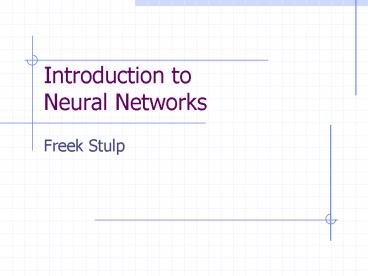Introduction to Neural Networks - PowerPoint PPT Presentation
1 / 12
Title:
Introduction to Neural Networks
Description:
Perceptrons can learn mappings from inputs I to outputs O by changing weights W. Training set D: ... Stuart Russel and Peter Norvig. Machine Learning. Tom M. Mitchell ... – PowerPoint PPT presentation
Number of Views:45
Avg rating:3.0/5.0
Title: Introduction to Neural Networks
1
Introduction to Neural Networks
- Freek Stulp
2
Overview
- Biological Background
- Artificial Neuron
- Classes of Neural Networks
- Perceptrons
- Multi-Layered Feed-Forward Networks
- Recurrent Networks
- Conclusion
3
Biological Background
- Neuron consists of
- Cell body
- Dendrites
- Axon
- Synapses
- Neural activation
- Throught dendrites/axon
- Synapses have different strengths
4
Artificial Neuron
Input links (dendrites)
Unit (cell body)
Output links (axon)
aj
Wji
ai
5
Class I Perceptron
6
Learning in Perceptrons
- Perceptrons can learn mappings from inputs I to
outputs O by changing weights W - Training set D
- Inputs I0, I1 ... In
- Targets T0, T1 ...Tn
- Example boolean ORD
- Output O of network is not necessary equal to T!
7
Learning in Perceptrons
- Error often defined as E(W)
1/2Sd?D(td-od)2 - Go towards the minimum error!
- Update rules
- wi wi Dwi
- Dwi -hdE/dwi
- dE/dwi d/dwi 1/2Sd?D(td-od)2
Sd?D(td-od)iid - This is called gradient descent
i
8
Class II Multi-layer Feed-forward Networks
- Feed-forward
- Output links only connected to input links in the
next layer
- Complex non-linear functions can be represented
9
Learning in MLFF Networks
- For output layer, weight updating similar to
perceptrons. - Problem What are the errors in the hidden layer?
- Backpropagation Algorithm
- For each hidden layer (from output to input)
- For each unit in the layer determine how much it
contributed to the errors in the previous layer. - Adapt the weight according to this contribution
- This is also gradient descent
10
Class III Recurrent Networks
- No restrictions on connections
- Behaviour more difficult to predict/ understand
11
Conclusion
- Inspiration from biology, though artificial
brains are still very far away. - Perceptrons too simple for most problems.
- MLFF Networks good as function approximators.
- Many of your articles use these networks!
- Recurrent networks complex but useful too.
12
Literature
- Artificial Intelligence A Modern Approach
- Stuart Russel and Peter Norvig
- Machine Learning
- Tom M. Mitchell
















![Introduction to Artificial Neuron Networks [ANN] PowerPoint PPT Presentation](https://s3.amazonaws.com/images.powershow.com/6292342.th0.jpg?_=20150319091)














